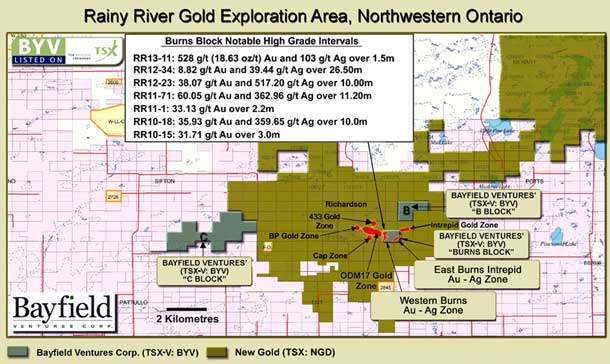

Mining – Economy – Drilling – Exploration – Discovery
THUNDER BAY – Bayfield Ventures Corp. have announced further assays results from the continuing exploration drill program at the Company’s Burns Block gold-silver project, Rainy River district, north-western Ontario. The Burns Block is located adjacent to the east of New Gold’s multi-million ounce Rainy River gold-silver deposit and adjacent to the west of New Gold’s expanding Intrepid gold-silver zone.
Greenland Debates Mining Law
Mining.com is reporting, “Greenland’s parliament is set to discuss once again a contentious mining law passed in December last year, which relaxes regulations for resource companies to establish mines and other raw materials operations in the self-governing territory.
“The ruling’s most controversial point is the one that allows miners with projects valued at roughly $1 billion (more than 5 billion kroner) to enter into agreements with foreign trade unions, which opponents say it would likely lead to bringing underpaid foreign labour, a practice known as “social dumping”.
Canadian Miner Announces Discovery of “Largest Kimberlites”
TORONTO – Pangolin Diamonds Corp. has announced that it has discovered one of the largest kimberlites in the world, modeled at 270 hectares (2.7 km2), at its 100% owned Tsabong North Project (the “Project”) in Botswana.
A number of the world’s largest kimberlites include:
– Se251 in Angola, measuring 220 hectares (2.2 km2)
– MK1 in Botswana, measuring 180 hectares (1.8 km2)
– Mwadui in Tanzania, measuring 146 hectares (1.46 km2)
Kimberlite Discovery
The new discovery stems from Pangolin’s discovery earlier this year of two kimberlites, Magi-01 and Magi-02, at its Tsabong North Project.
Aeromagnetic data on those finds was submitted by Pangolin for independent review by Mr. Billy Steenkamp, of Xcalibur Airborne Geophysics of Pretoria, South Africa. Mr. Steenkamp is a Qualified Person under National Instrument 43-101 rules. His observations include the following:
The previously reported Magi kimberlites are part of a single intrusive complex with a total surface area estimated at 270 Hectares (2.7 km2):
Some of the selected intrusive kimberlite targets could be of syn- or pre-Karoo age; and
Two new kimberlite drill targets have been identified with total intrusive areas modeled at 170 Hectares (1.7 km2) and 175 Hectares (1.75 km2).
Based on these observations, Pangolin drilled a new hole between the Magi-01 and Magi-02 kimberlites. The new hole positively intersected the same sandy tuffs recognized in the two previous drill holes, confirming that the Magi-Kimberlite is a single large body and not two smaller kimberlites as previously believed.
Once Thriving Mining Sector Hobbled By Financing Issues
WHITEHORSE – “A once-thriving mining sector is now re-evaluating development and exploration plans due to lower commodity prices and tight capital markets, which makes it difficult for mining companies to obtain financing,” said Glen Hodgson, Senior Vice-President and Chief Economist, The Conference Board of Canada. “However, the outlook beyond this year is more promising. Economic growth in the territories over the next few years is expected to easily outpace growth in most other Canadian regions.”
Lower commodity prices will hold back mineral exploration in Canada’s territories, cooling previously-robust economic growth in the territories this year.
Real gross domestic product (GDP) in the territories is forecast to grow by a tepid 0.5 per cent in 2013, according to The Conference Board of Canada’s Territorial Outlook: Autumn 2013, released Monday at Canada’s North Summit 2013 in Whitehorse.
Highlights
- Spending on mineral exploration is expected to be down in all three territories this year, with Nunavut experiencing the largest decline.
- Real GDP in the territories will increase by 0.5 per cent in 2013, below recent economic performances.
- The medium term is promising; economic growth in the territories over the next few years is expected to easily outpace growth in most other regions of Canada.
Real GDP in the territories as a whole is expected to expand by a more robust 3.2 per cent in 2014 and 4.2 per cent in 2015. While a given mining project is never guaranteed to proceed, favourable global demand for metals suggest that Canada’s mining potential is bright over the next decade—particularly in the North.
This year, Yukon’s mining industry saw production and staffing cutbacks. Victoria Gold delayed construction of its Eagle mine by a year, and Yukon Zinc and Alexco Resource announced they were cutting production and laying off workers in the summer. Economic growth in the territory will be limited to 0.6 per cent this year. With two new mines expected to begin construction, Yukon’s economic prospects will be more positive next year, with real GDP expected to rise by 5.7 per cent.





